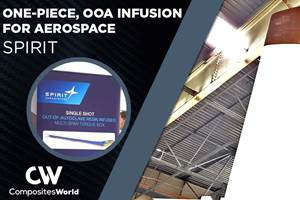Molding with compression? Choose wisely you must
For those in the market for a compression molding machine — either to replace an aging machine or to add new capability — must be prepared to answer serious questions about the material and application for which it will be molded.
In the composites industry, compression molding is among the apparently simplest processes available for fabrication: Insert material, close mold, add pressure, add heat, wait, cool mold, open mold, remove part. Repeat. On top of that, compression molding minimizes touch labor and offers high repeatability, if done right. For that reason, this process has become highly attractive for parts ranging from aircraft fuselage clips to automotive panels.
However, those in the market for a compression molding machine — either to replace an aging machine or to add new capability — must be prepared to answer serious questions about the material and application for which it will be molded. That advice comes from Greenerd Press & Machine Co.’s (Nashua, NH, US) applications manager Tom Lavoie and design engineer Tim Wilson, who provided CW the following perspective on current compression molding technology.
First, says Lavoie, know your application: “Delve into the process you’re engaging in. Visit people already doing it to understand the process and challenges. If you understand what you need to achieve, then we can give you the ability to do the job.” Application specifics that impact compression process choices include resin type, fiber type, part size, part complexity, pressure requirements, heating requirements, cooling requirements, heating/ cooling rate requirements, tolerance requirements, mold bed size, mold clamping technology, daylight requirements, stroke requirements, clamp closing/opening speed requirements and dwell time. Just to name a few.
All of these data are required because compression molding technology has become so sophisticated that a machine can be tailored to meet the needs of a specific application. Wilson notes, for example, that a dwell time of just a few minutes dictates use of one type of hydraulic circuitry, while a dwell time of several hours dictates hydraulic circuitry of another type entirely. A press that will produce long runs of a single type of part might need fairly simple control circuitry. If the press will be used for a lot of development work, however, its control package will necessarily be more complex to offer greater flexibility.
In fact, nowhere has compression technology advanced so much as in the control systems. Wilson says contemporary controls provide substantially better feedback than ever, with closed loop technology now standard on clamp pressure, proportional relief valves, linear position, and temperature. The result? Nearly instant feedback on machine and process performance.
“With the feedback we can offer today,” says Lavoie, “we know what the press is doing and can tell very quickly if a part is not ‘to spec.’ In many cases, the machine will know before you do.”
Other benefits of improved control systems include more accurate temperature ramping (up and down), finer motor control, faster stroke sequences and greater posi- tional accuracy.
Finally, says Lavoie, molders must be prepared to talk realistically about what they need. Some customers, he says, want ±1°F temperature control across the platen, or expect ±0.0001-inch press frame deflection. “Those specs would be very expensive,” he says, “and almost always unnecessary. We do a good job helping customers determine their true needs to ensure they receive the optimal press design at the right investment to achieve their operational requirements.”
Related Content
CompPair adds swift prepreg line to HealTech Standard product family
The HealTech Standard product family from CompPair has been expanded with the addition of CS02, a swift prepreg line.
Read MoreVIDEO: One-Piece, OOA Infusion for Aerospace Composites
Tier-1 aerostructures manufacturer Spirit AeroSystems developed an out-of-autoclave (OOA), one-shot resin infusion process to reduce weight, labor and fasteners for a multi-spar aircraft torque box.
Read MorePEEK vs. PEKK vs. PAEK and continuous compression molding
Suppliers of thermoplastics and carbon fiber chime in regarding PEEK vs. PEKK, and now PAEK, as well as in-situ consolidation — the supply chain for thermoplastic tape composites continues to evolve.
Read MoreGKN Aerospace, Joby Aviation sign aerostructures agreement
GKN Aerospace will manufacture thermoplastic composite flight control surfaces for Joby’s all-electric, four-passenger, composites-intensive ride-sharing aircraft.
Read MoreRead Next
Plant tour: Daher Shap’in TechCenter and composites production plant, Saint-Aignan-de-Grandlieu, France
Co-located R&D and production advance OOA thermosets, thermoplastics, welding, recycling and digital technologies for faster processing and certification of lighter, more sustainable composites.
Read MoreVIDEO: High-volume processing for fiberglass components
Cannon Ergos, a company specializing in high-ton presses and equipment for composites fabrication and plastics processing, displayed automotive and industrial components at CAMX 2024.
Read More“Structured air” TPS safeguards composite structures
Powered by an 85% air/15% pure polyimide aerogel, Blueshift’s novel material system protects structures during transient thermal events from -200°C to beyond 2400°C for rockets, battery boxes and more.
Read More






















